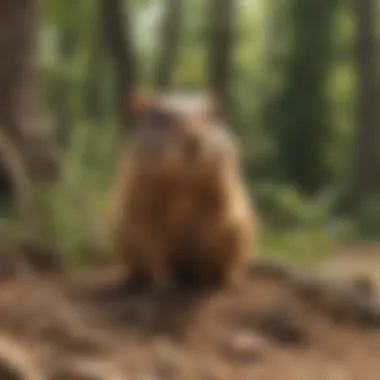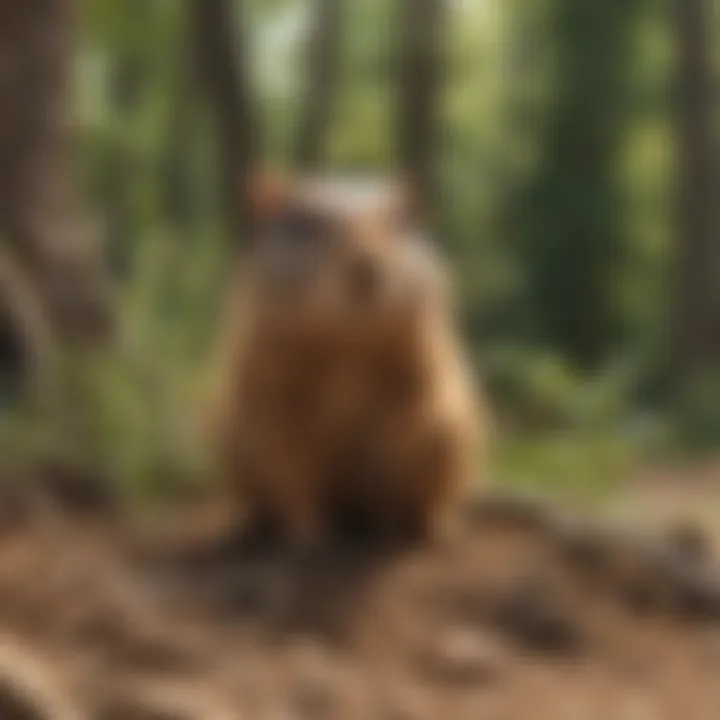Protecting Trees from Gopher Damage: Strategies


Intro
Gophers, while small and often overlooked, pose a significant threat to the structural integrity of trees, particularly when they inhabit gardens and landscapes. Understanding how these pests operate is crucial for anyone looking to maintain a healthy environment for their plants. The damage caused by gophers to tree roots can be devastating, potentially leading to the decline or death of trees that have taken years, even decades, to mature. Preventive measures and effective solutions are therefore not just beneficial but essential for homeowners who value their gardens.
This article will delve into the biological habits of gophers, the impact of their activities on trees, and practical prevention methods. With this knowledge, gardeners and homeowners can create a strategy that not only protects trees but also promotes ecological sustainability.
Understanding Pests
Definition of Pests
In the context of gardening and landscaping, pests are organisms that cause harm to plants, disrupt ecosystems, or negatively affect human activities. Gophers fit this definition as they can damage tree roots, disrupt soil structure, and ultimately affect the health of the entire garden ecosystem.
Importance of Pest Identification
Identifying gophers and their signs of activity is crucial to effective pest management. Knowing the specific pest allows for targeted strategies that prevent damage without affecting beneficial organisms. Gophers create distinctive tunnels and mounds in the soil, which can help in recognizing their presence. Understanding their behavior and habits, such as their feeding patterns and preferred environments, can also guide prevention efforts.
Prevention Techniques
Home and Garden Preventative Measures
Several effective preventive measures can be implemented to keep gophers at bay. These include:
- Physical Barriers: Installing underground fencing made of wire mesh around the trees can help prevent gophers from accessing roots.
- Ground Cover: Planting ground covers that are less appealing to gophers can minimize their interest in your garden.
- Regular Monitoring: Periodically inspecting the garden for signs of gopher activity allows for early detection and intervention.
Seasonal Prevention Tips
Gopher activity can fluctuate with the seasons, so adapting strategies throughout the year is beneficial. During spring, when gophers are more active, consider the following:
- Tilling the Soil: This can disrupt existing tunnels and deter gophers from settling.
- Planting During Off-Peak Times: Avoid planting new trees during peak gopher activity periods, which tends to be in spring and fall.
Eco-Friendly Pest Control Solutions
Overview of Sustainable Practices
Employing sustainable practices for pest control is vital not only for protecting trees but also for maintaining an ecological balance. This includes avoiding harmful chemicals that affect beneficial insects and soil health. Consider using natural repellents made from scents that gophers dislike, such as castor oil or predator urine, to keep them away from tree roots.
Natural Remedies and Their Effectiveness
Several natural remedies have been shown to deter gophers effectively. Some popular solutions include:
- Castor Oil: Mixing castor oil with water and applying it to the soil can help repel gophers due to its strong odor.
- Essential Oils: Oils like peppermint can act as a natural deterrent when diluted and sprayed around the garden.
- Planting Certain Plants: Plants such as garlic and marigold are believed to repel gophers, serving dual roles in enhancing garden aesthetics while protecting tree roots.
"Understanding gopher behavior and employing various control measures can protect trees and maintain healthy landscapes."
Understanding Gopher Behavior
Gopher behavior is crucial for anyone aiming to protect their trees from damage. Understanding how gophers operate can lead to more effective prevention strategies. These small mammals, known for their burrowing habits, can do substantial harm to tree roots if left unchecked. Their activities not only damage the trees but can also disrupt the soil structure, impacting overall garden health. By learning about gopher behavior, homeowners can make informed decisions about which control measures to adopt.
Habitat and Distribution
Gophers typically thrive in areas with soft, well-aerated soil, which is ideal for their extensive burrowing. They prefer gardens, parks, and agricultural fields where they have access to a variety of plants. In the United States, the most common types include the pocket gopher, found widely across the Midwest and Western regions. Knowing where gophers are likely to live helps in targeting prevention methods. Monitoring regions known for gopher activity can allow homeowners to take proactive measures to protect their trees.
Diet and Feeding Patterns
Gophers are herbivorous and primarily consume plant materials. Their diet consists of roots, tubers, and the tender stems of various plants. This feeding behavior poses a direct threat to trees, especially when gophers dig around the base. The feeding pattern reveals that their preference often includes young and newly planted trees, making understanding this aspect essential for gardeners. By identifying which plant species attract gophers, homeowners can make strategic plant selections.
Reproductive Habits
Gophers breed quickly throughout the year. A single female can produce multiple litters annually, with each litter containing several young. This rapid reproduction means that once gophers establish in an area, their population can grow swiftly. For homeowners, this indicates the urgency of addressing gopher issues upon identification. Monitoring for signs of gophers early can mitigate the risks of infestations that threaten tree roots.


The Importance of Tree Root Health
Tree roots serve as the foundation of a tree’s vitality and health. Their role is not merely about supporting the tree physically; roots are also essential for water and nutrient uptake, enabling the tree to thrive. Healthy tree roots ensure stability and resilience against environmental stresses, pests, and diseases. When roots are compromised, it can lead to a decline in the overall health of the tree, making it more susceptible to various problems that can impact both the tree itself and the surrounding ecosystem.
One of the key benefits of maintaining healthy roots is efficient nutrient absorption. Roots are equipped to take in water and essential minerals from the soil. These nutrients are critical for photosynthesis and growth. Without healthy roots, a tree struggles to access these resources, which can lead to stunted growth or even death.
Additionally, healthy roots contribute to soil health. They help in aerating the soil, improving its structure and allowing beneficial microorganisms to thrive. This interaction creates a balanced ecosystem that enhances the overall fertility of the planting area.
Furthermore, root health is linked to preventing erosion. Trees with robust root systems bind the soil, reducing the risk of land degradation. This function is particularly important for areas prone to heavy rains or wind.
Due to these various roles, ensuring tree root health becomes paramount when considering the threats posed by gophers. Gophers, as we will see in the following sections, can severely damage these roots, leading to detrimental effects on the overall health of the trees.
Tree Root Functions
The primary functions of tree roots include:
- Anchorage: Roots anchor the tree in place, preventing it from toppling over during storms or high winds.
- Nutrient and Water Uptake: Roots absorb essential nutrients and water from the soil, which are crucial for the tree's growth.
- Storage: Roots store carbohydrates and other nutrients to sustain the tree during periods of dormancy or stress.
- Soil Improvement: By breaking up soil, roots improve aeration, contributing to a healthier environment for other plants.
This interplay makes it clear that a healthy root system is vital for maintaining the resilience of a tree against various threats, including those posed by gophers and other pests.
Impact of Root Damage
When tree roots become damaged, the consequences can be severe. Damage can lead to reduced nutrient and water uptake, causing symptoms like wilting, yellowing leaves, or stunted growth. A compromised root system may cause trees to fall behind in restoration efforts after stress events, impacting their ability to photosynthesize effectively.
Moreover, root damage can lead to a decline in tree stability. Trees that experience root compromise are at a greater risk of being uprooted in adverse weather conditions. The implications extend beyond the immediate tree; weakened trees can disrupt local ecosystems which rely on healthy, stable flora.
In urban settings, damaged roots may also compromise sidewalks and other structures, leading to costly repairs.
"Understanding the importance of tree root health is crucial for preventing long-term damage from pests like gophers. Protecting these roots is key to ensuring thriving landscapes and healthy environments."
Identifying Gopher Infestation
Identifying gopher infestation is crucial for maintaining the health of tree roots and ensuring the overall vitality of your landscape. Recognizing the early signs of gopher activity allows homeowners and gardeners to take timely action. Effective identification can deter further damage, protect tree health, and contribute to a balanced ecosystem.
Signs of Gopher Activity
Understanding the signs of gopher activity is the first step in identifying their presence. Gophers are underground dwellers, so their indicators might not always be visible at the surface. Here are key signs to watch for:
- Mounds of soil: Gophers create distinctive, crescent-shaped mounds of dirt as they dig tunnels. These mounds often appear near tree roots and can be markers of active burrowing.
- Damaged roots and plants: If you notice wilting trees or plants, especially if they show sudden decline, gophers could be the cause. They feed primarily on roots and can cause rapid damage, leading to plant death.
- Tunneling patterns: Look for paths that disrupt the soil surface. Gophers typically build extensive tunnels, and these can be easier to spot after heavy rainfall has altered the landscape.
- Gnawed vegetation: Gophers will often leave behind signs of their diet. If you find chewed limbs, bark, or exposed roots, these could be indicators of gopher feeding.
By being vigilant and noting these signs, homeowners can effectively monitor for gopher activities.
Assessing Damage to Tree Roots
Once potential signs of gopher infestations are noted, the next step involves assessing the extent of the damage to tree roots. This requires careful evaluation to determine how severely tree health might be affected:
- Visual Inspection: Start with a visual check of the tree. Look for signs of distress in tree leaves, bark, or overall shape, as these can be early indicators of root damage.
- Soil Erosion: Inspecting the soil around the base can give insights. If the soil appears loose or displaced, it might suggest root systems have been compromised by gophers.
- Check for Tunneling: Gently probing or digging around the base may reveal gopher tunnels. This can help determine the depth and extent of the burrowing and potential damage inflicted on roots.
- Root Examination: If accessible, inspect root systems directly. Severely damaged roots may appear chewed, discolored, or rotten, indicating damage that can hinder the tree’s nutrient intake.
Each of these assessment methods signifies the importance of timely identification and monitoring. Not only does it help in understanding the gopher impact, but it also forms the basis for deciding on an appropriate response strategy.
Preventive Measures Against Gophers
Preventive measures against gophers are essential for maintaining tree health. As pests, gophers can cause significant damage, especially to tree roots. Confronting this issue requires understanding various effective strategies to limit their impact. Creating a blend of physical barriers, selecting proper plants, and implementing sound soil management practices can safeguard tree roots from these burrowing rodents. Each strategy not only helps to deter gophers but also contributes to the broader health of the garden or orchard.
Physical Barriers
Physical barriers serve as one of the most direct methods to keep gophers away from trees. These barriers can prevent burrowing activity and protect roots.
Subsurface Fencing


Subsurface fencing is a method where barriers are installed below the surface of the ground. The key characteristic of subsurface fencing is its depth. Installing it deep enough discourages gophers from tunneling under the fence. This type of fencing is beneficial because it provides an long-lasting solution against these pests. A unique feature of subsurface fencing is the material used. Typically, materials like hardware cloth or thick wire mesh are common choices. The advantages include effectiveness and long durability. However, the installation process can be labor-intensive, requiring time and effort for proper setup.
Tree Wrapping
Tree wrapping involves encasing the base of the tree with protective materials. One of the main attributes of tree wrapping is its ability to create a physical barrier that gophers cannot easily penetrate. This choice is beneficial because it is simple to implement and cost-effective. Additionally, the unique feature is its adaptability to different tree types and sizes. However, it may require regular checks and adjustments to ensure it remains effective.
Mesh Screens
Mesh screens are another physical barrier, used to cover the root zone of the tree. The key aspect of mesh screens is their fine mesh grid, allowing air and water to reach the roots while keeping gophers out. This method is beneficial because it reduces the chances of root damage. A distinctive feature of mesh screens is they can be tailored to fit any tree size, adding versatility. The disadvantage can be that if not secured properly, they may displace or tear, leading to reduced effectiveness over time.
Plant Selection
Choosing the right plants plays a crucial role in preventing gopher damage. Gopher-resistant plants can significantly enhance the defenses of your garden.
Gopher-Resistant Plants
Gopher-resistant plants are specific species that gophers typically avoid. The primary characteristic of these plants is their unique chemical composition that deters gophers from munching on their roots. Selecting such plants is a beneficial choice because it naturally reduces the risk of gopher-related root damage. Some examples include plants with strong scents or tough textures. The advantages are clear, as planting these types can minimize the need for other control methods. However, these plants may not thrive in all soil types or climates, which is something to consider.
Complementary Planting Strategies
Complementary planting strategies consist of arranging plants in a manner that enhances their growth while deterring pests. The main feature of these strategies is the diversity of plant species. By mixing gopher-resistant species with other flowers or shrubs, it creates a more balanced ecosystem. This method is beneficial as it can improve soil health and resilience against pests. A unique aspect of complementary planting is that it encourages beneficial insects while repelling gophers. Disadvantages include the need for knowledge about compatible plant species, which may require more initial planning and research.
Soil Management Practices
Proper soil management is another key aspect in safeguarding tree roots from gophers. This means enhancing the soil structure can discourage gopher activity.
Improving Soil Density
Improving soil density involves compacting the soil around tree roots. This method is beneficial because a denser soil layer can make it more challenging for gophers to dig. A key characteristic is achieving the balance between aeration and compaction. The unique feature of this practice is its ability to promote overall plant health. However, the disadvantage includes the need for ongoing monitoring. Too much compaction can impact root growth.
Implementing Mulching Techniques
Implementing mulching techniques involves adding organic material on top of the soil. The main characteristic of mulching is its ability to retain moisture while also creating a physical barrier. This choice is beneficial as it prevents soil erosion and provides nutrients over time. A unique aspect is that mulching contributes to soil health and can attract beneficial organisms. However, it may need regular replenishment to maintain effectiveness, especially in areas prone to gopher activity.
Effective preventive measures against gophers combine multiple strategies. Physical barriers, plant choice, and soil management create comprehensive protection for trees. Investing time in these methods pays off in healthier trees and gardens.
Ecological Control Methods
Ecological control methods offer practical and sustainable strategies for managing gopher populations without relying heavily on chemical interventions. These methods focus on leveraging natural ecosystems to minimize gopher damage to tree roots. Their relevance lies in promoting a healthier environment while protecting essential tree systems. Through understanding and implementing ecological control methods, individuals can create a balanced approach to pest management that aligns with principles of sustainability.
Natural Predators
Encouraging Predatory Species
Encouraging predatory species is a vital strategy in the ecological control of gophers. Predators such as owls, hawks, and snakes can effectively reduce gopher populations by preying on them. The key characteristic of this method is its reliance on the natural food chain, which often results in a more balanced ecosystem.
This approach is beneficial because it fosters biodiversity. By attracting these predatory animals to your garden or property, you create a natural safeguard against gopher infestations. One unique feature of this method is that it promotes an environmentally friendly way to control pests.
While encouraging predatory species has multiple advantages, there are challenges as well. Predators may require specific types of habitats and conditions to thrive, which means that property owners might need to adjust their landscaping or maintenance routines to support these species.
Creating a Balanced Habitat
Creating a balanced habitat is another effective method for fostering ecological control. This involves enhancing the environment to support diverse wildlife, including natural predators of gophers. The key characteristic of this approach is its holistic focus on ecosystem health, making it a popular choice for maintaining a thriving landscape.
A unique feature is the planting of native vegetation and installing water sources, which can attract beneficial insects and animals that encourage a balanced ecosystem. These changes can help to create a natural barrier for gophers and other pests.
The advantages of creating a balanced habitat include reduced reliance on synthetic pesticides and fostering an environment that naturally regulates pest populations. However, challenges may arise, such as maintaining balance in the habitat over time and dealing with potential competition among wildlife species, which requires continuous efforts.
Eco-Friendly Repellents


Eco-friendly repellents represent another layer of ecological control methods. These repellents are derived from natural ingredients and are designed to deter gophers without causing harm to the surrounding environment. Examples include castor oil and essential oils like peppermint.
The benefit of using eco-friendly repellents lies in their safety for both plants and wildlife, making them suitable for gardens and residential areas. Furthermore, they contribute to sustainable gardening practices by reducing chemical runoff into the soil and waterways.
It’s essential to apply these repellents consistently for maximum effectiveness. Many homeowners appreciate their ease of use and the fact that they often come with fewer environmental considerations, compared to traditional chemical options.
Chemical Control Options
Chemical control options are important components in managing gopher populations that threaten tree root integrity. While ecological methods should always be prioritized, there are instances when chemical solutions offer effective results, particularly in severe infestations. Employing these options must be done with careful consideration of their application and potential effects on the environment. Understanding the types of baits available and being aware of safety practices serves as a foundation for responsible management.
Types of Baits Available
When it comes to chemical control, gopher baits can vary significantly in formulation and active ingredients. Many homeowners utilize these products to address established infestations effectively. The following types of baits are commonly used:
- Rodenticides with anticoagulants: These types of baits work by preventing blood clotting, ultimately leading to the animal's death. They are effective but require a longer time to take action.
- Cholecalciferol-based baits: Often recognized by their potency, these baits lead to fatal kidney damage in gophers. They can be seen as quicker alternatives compared to anticoagulants, providing significant results within a few days.
- Bromethalin baits: This is a neurotoxin that impacts the nervous system of gophers, leading to a quicker death. Its application must be done carefully due to its higher risk of secondary poisoning.
For anyone using these baits, proper application is crucial. Follow manufacturer instructions to minimize any associated risks while ensuring the product reaches its target effectively.
Safety and Environmental Concerns
Using chemical control options raises valid concerns regarding safety and environmental impacts. When dealing with these substances, it is vital to integrate safety measures into the process. Risks can extend beyond the targeted pest, affecting other wildlife and pets. The following considerations should be taken into account:
- Follow Instructions: Always abide by the manufacturer's guidelines to prevent over-application and minimize risks.
- Protect Non-target Species: The use of bait stations can help reduce accidental ingestion by pets or other wildlife. Placing baits underground and in concealed areas will protect surrounding fauna.
- Residual Impact: Be aware that certain rodenticides may linger in the environment, potentially affecting soil and water quality. Choose biodegradable options when available.
- Disposal: Dispose of any unused bait according to local regulations. This helps ensure that residues do not contaminate the environment.
"Chemical control should not be the first line of defense. It must be balanced judiciously with ecological practices to maintain a healthy garden ecosystem."
Thus, while chemical control options provide efficient solutions for managing gopher infestations that threaten tree roots, a comprehensive understanding of their types, application techniques, and safety is essential. The combination of responsible use and ecological awareness can lead to effective gopher management while preserving environmental integrity.
Monitoring and Maintenance
Monitoring and maintenance play a crucial role in preventing gophers from damaging tree roots. Effective management begins with regular observation and assessment of your landscape. This proactive approach not only helps in early detection of gopher activity but also informs your ongoing pest control strategies. A consistent monitoring plan allows for timely interventions, which can significantly reduce the risk of severe damage to your trees.
Regular Inspections
Regular inspections are essential to maintaining healthy tree roots. Conducting these assessments helps identify any signs of gopher activity early on. Look for fresh mounds of soil or tunnel openings in the vicinity of your trees. Documenting these signs can aid in analyzing patterns over time, allowing you to make informed decisions.
During these inspections, pay attention to the overall condition of your trees. Healthy trees can usually withstand some level of disturbance. However, if you notice wilting leaves or stunted growth, this may be a signal that the roots are under stress, potentially due to gopher activity.
Adjusting Strategies Based on Findings
Based on your inspection results, you may need to adjust your pest control strategies. If gopher activity is detected, consider revisiting your preventive measures. For example, if you've implemented physical barriers, ensure they are intact and not compromised. If you have noticed that certain types of plants are more affected than others, analyze their planting locations. This can help you determine if the issue is plant-specific or indicative of a wider gopher problem.
Moreover, adapting your strategies may include switching to more effective eco-friendly repellents or enhancing soil management practices.
In summary, monitoring and maintenance are integral components in safeguarding your trees. By remaining observant and responsive to the conditions in your landscape, you can effectively shield your trees from potential gopher damage.
Culmination and Future Considerations
In exploring effective strategies for gopher management, it is essential to recognize that proactive measures are more effective than reactive ones. This article synthesizes critical insights into the behaviors of gophers, the potential damage they cause to tree roots, and diverse methods for prevention. Understanding this topic is vital for homeowners who desire not only a beautiful landscape but also a healthy ecosystem.
Long-term Gopher Management
Successful long-term gopher management involves a combination of consistent monitoring, adaptation of strategies, and education. Knowing the specific timing of gopher activity can help in implementing preventive measures that are both effective and economical. Homeowners should
- Regularly assess their landscape for signs of gopher activity, such as fresh mounds or digging.
- Utilize a blend of physical barriers, eco-friendly repellents, and natural predators, creating a multi-faceted approach.
- Reevaluate the effectiveness of these methods periodically. For instance, if a certain plant type shows vulnerability, homeowners might consider alternative gopher-resistant species.
By implementing such steps, one can establish a strong defense against gopher-related damage over the years.
Incorporating Sustainable Practices
Sustainable practices in gopher management offer numerous benefits. Homeowners can emphasize organic and natural methods to protect tree roots effectively while minimizing harm to the surrounding ecosystem. These include:
- Promoting Biodiversity: By planting a variety of native plants, the landscape becomes more resilient against pests, including gophers.
- Using Mulch Wisely: Applying organic mulch not only maintains soil moisture but also can deter certain pests when combined with measures like garlic or hot pepper sprays.
- Regular Education: Staying informed about the latest sustainable practices will empower homeowners to adapt their methods against gophers and improve overall landscape health.
In the pursuit of a healthy and thriving landscape, each decision made can contribute to a more balanced ecosystem.



